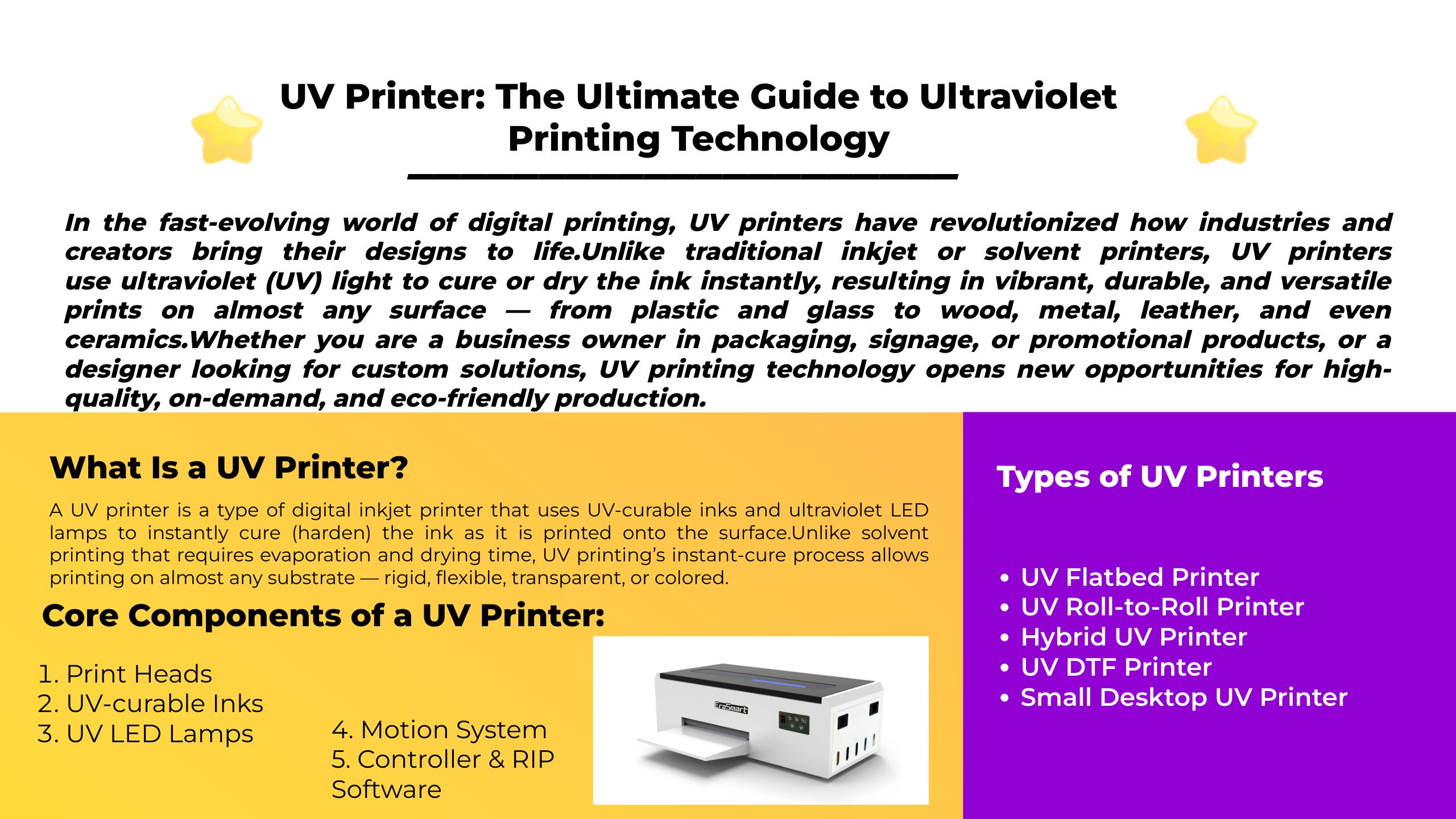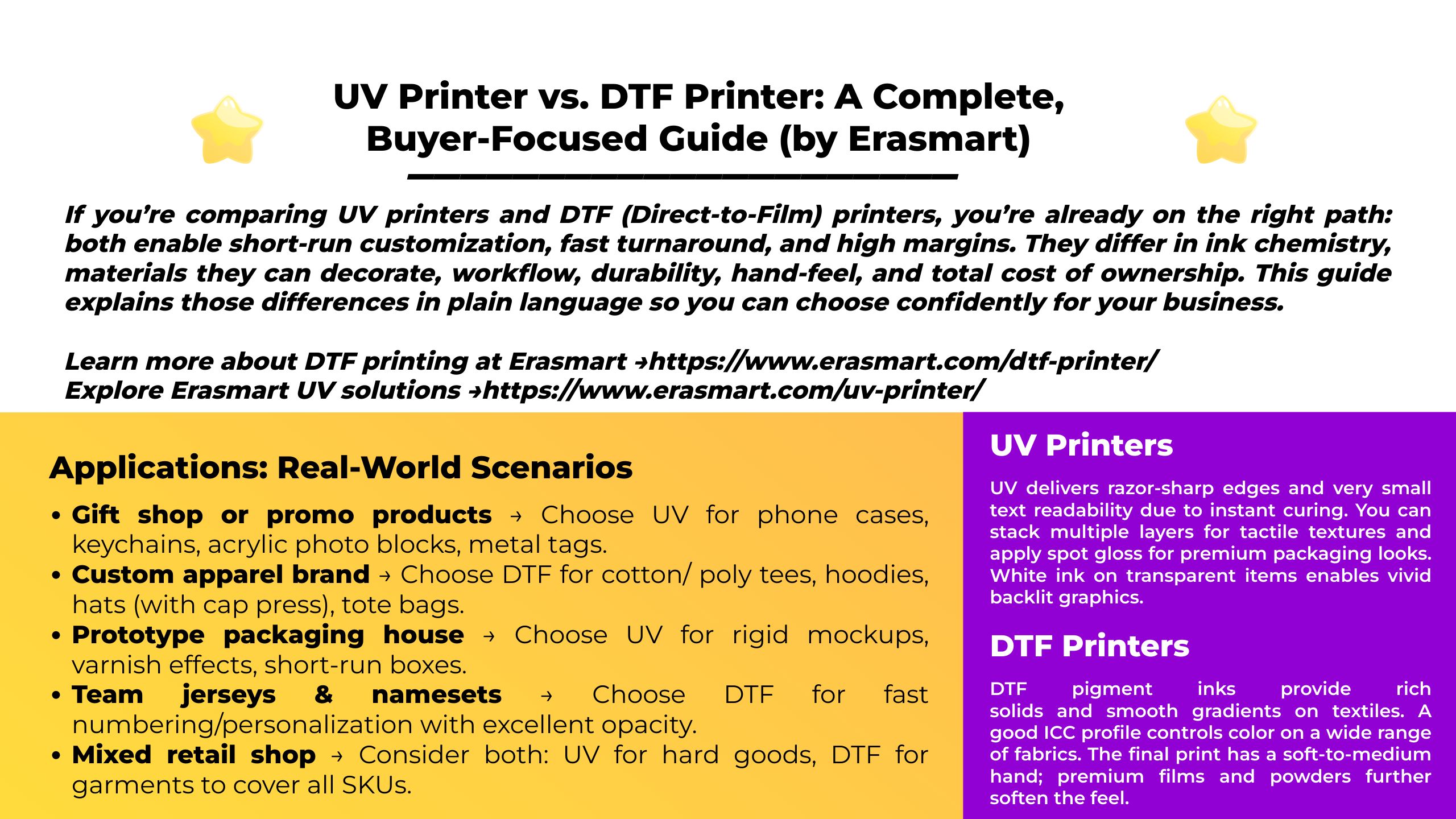Pourquoi choisir une imprimante DTF ? Un guide d’achat pratique pour une décoration de vêtements rapide et flexible

Le monde de la décoration textile et de l’impression de vêtements a évolué rapidement au cours de la dernière décennie. De la sérigraphie traditionnelle au vinyle à transfert thermique (HTV) en passant par la sublimation, chaque méthode a ses avantages et ses limites. Mais maintenant, une nouvelle technologie est transformer l'industrie de l'impression de vêtements: le Imprimante DTF (Direct-to-Film).
Si vous vous demandez : « Pourquoi choisir une imprimante DTF plutôt que d'autres méthodes d'impression ? », la réponse réside dans sa polyvalence, sa rentabilité et sa qualité d'impression supérieure. Dans ce guide, nous explorerons les raisons pour lesquelles les imprimantes DTF sont devenues le choix incontournable des imprimeries, des marques de vêtements et des entreprises de produits personnalisés du monde entier.
UN imprimante DTF est une machine d'impression numérique spécialisée conçue pour imprimer des motifs directement sur Film de transfert d'animaux, qui est ensuite pressé à chaud sur les tissus. Contrairement à la sublimation (limitée au polyester) ou au HTV (nécessite une découpe et un désherbage), les imprimantes DTF permettent d'imprimer images en couleur de qualité photo qui adhèrent de manière permanente à une grande variété de tissus.
Comment ça marche :
- Conception est créé numériquement (Photoshop, Illustrator, CorelDRAW, etc.).
- Impression: L'imprimante DTF imprime le motif sur un film PET en utilisant Encres DTF (CMJN + Blanc).
- Poudre adhésive est appliqué sur l’encre humide.
- Durcissement: La poudre est fondue à chaud pour préparer le transfert.
- Transfert de chaleur: Un film PET est posé sur le vêtement et pressé à chaud.
- Peler et finir: Le film se décolle, laissant une impression vibrante et durable.
Imprimante Erasmart DTF
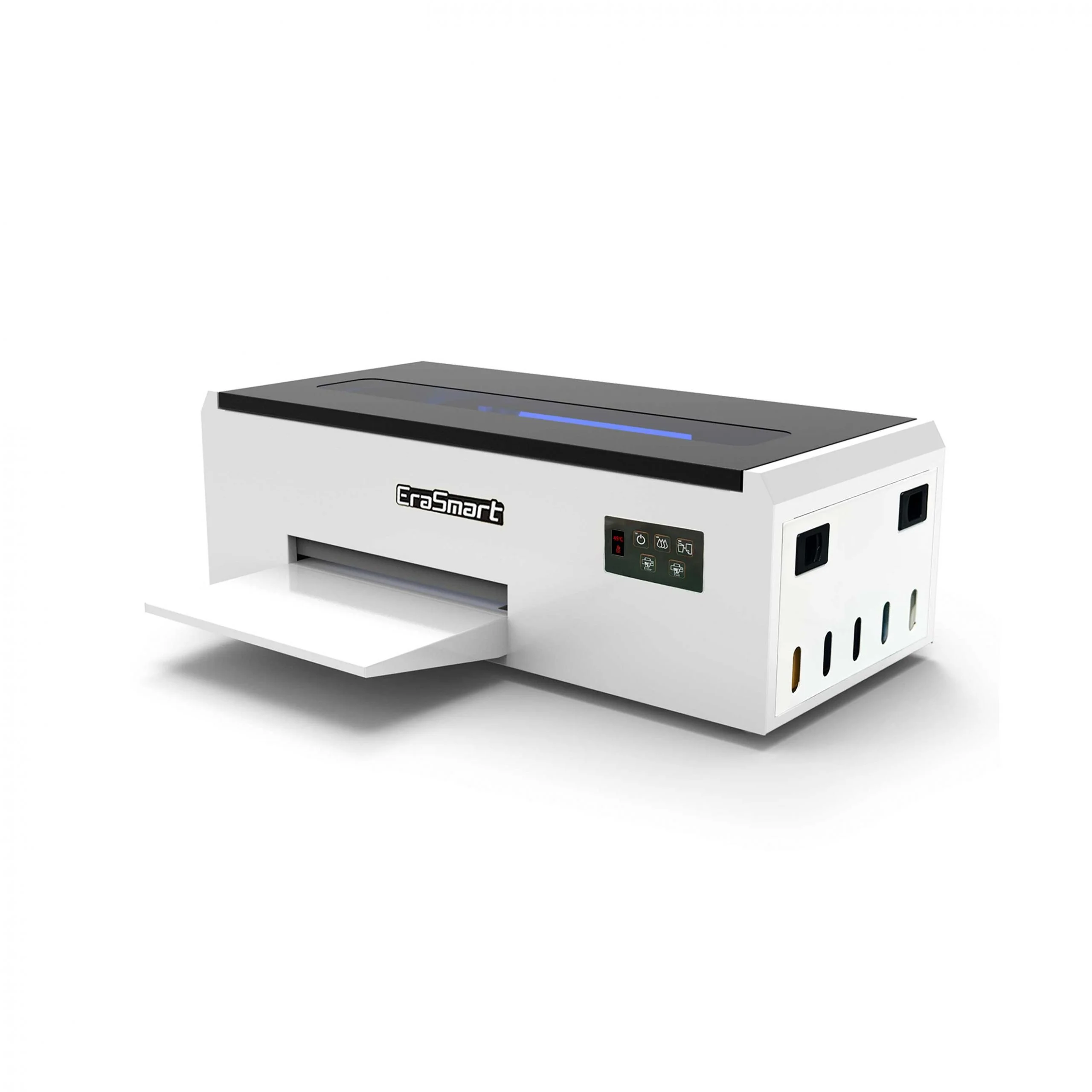
Modèle compact d'entrée de gamme parfait pour les startups et la production de petits lots.
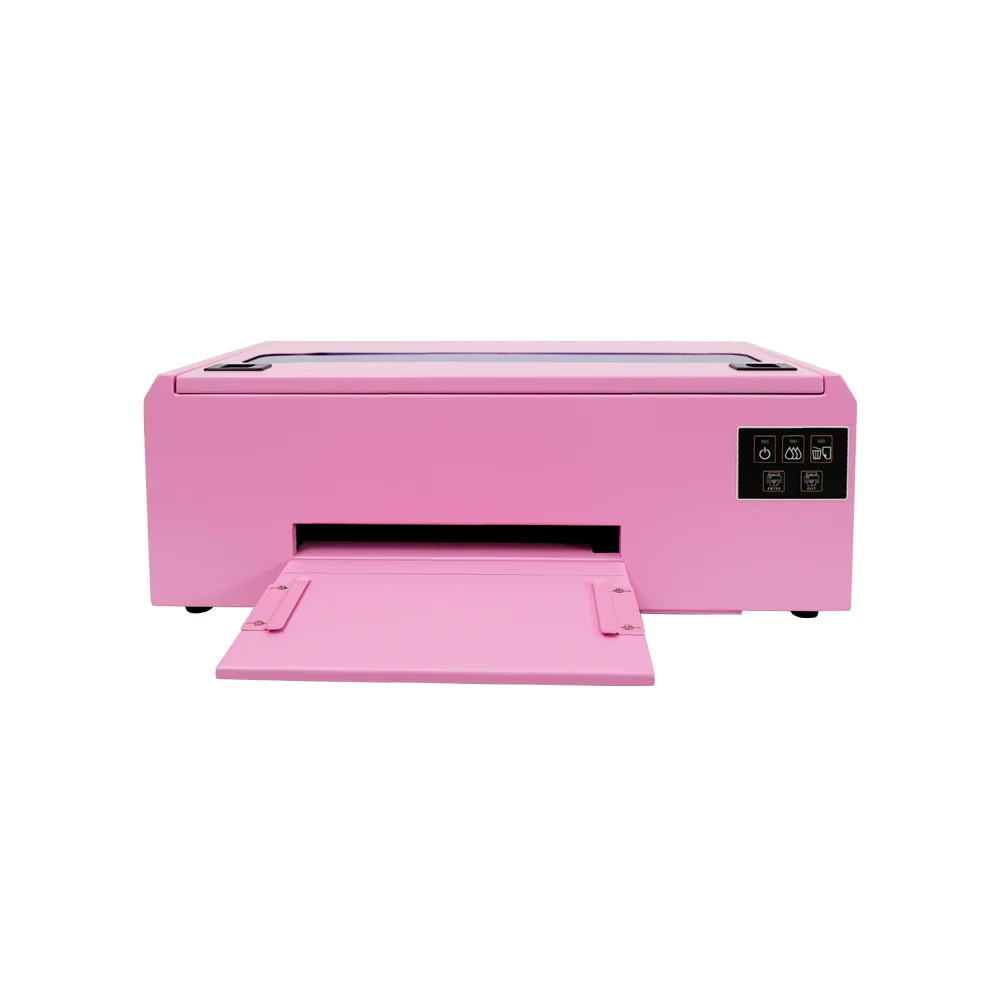
Modèle A4 amélioré avec une efficacité d'encre améliorée pour la production quotidienne à petite échelle.
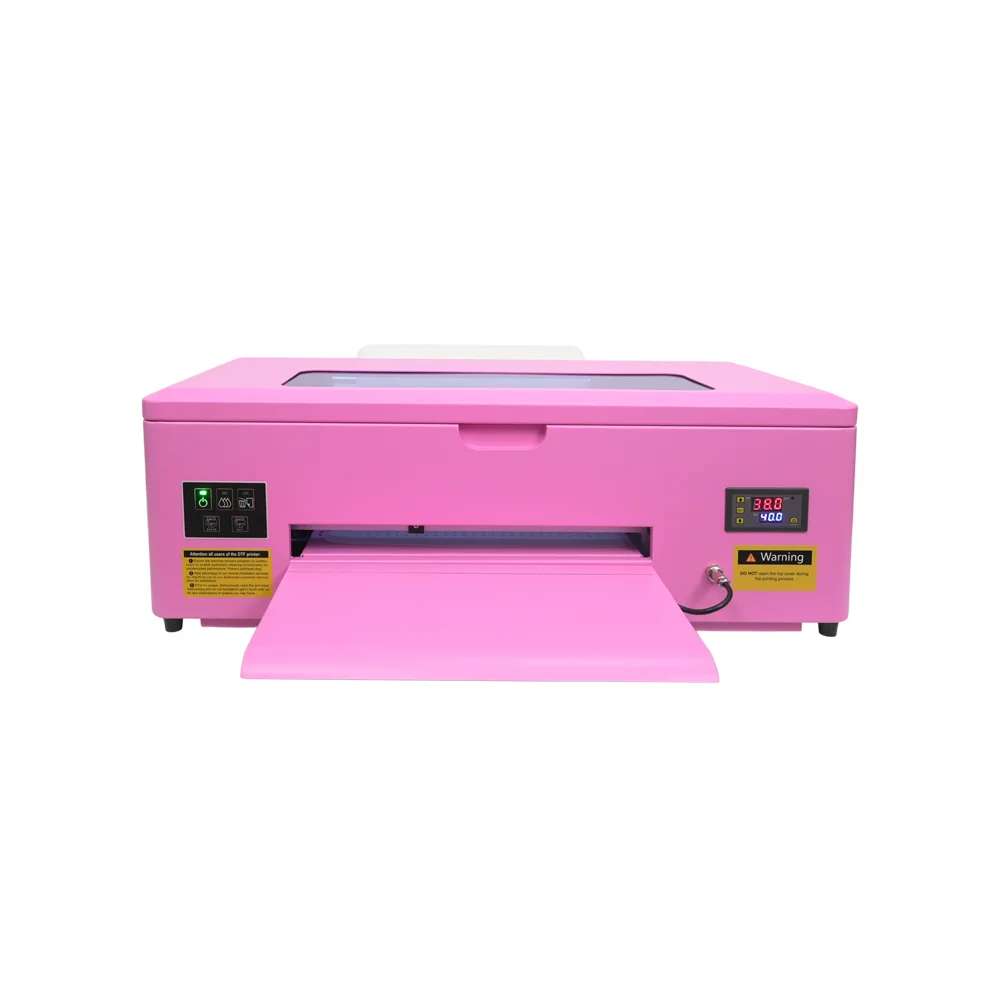
Imprimante au format A3 avec carte mère R1390 fiable pour la production moyenne.

Modèle A3 standard avec des réservoirs d'encre de 250 ml pour un fonctionnement quotidien cohérent.
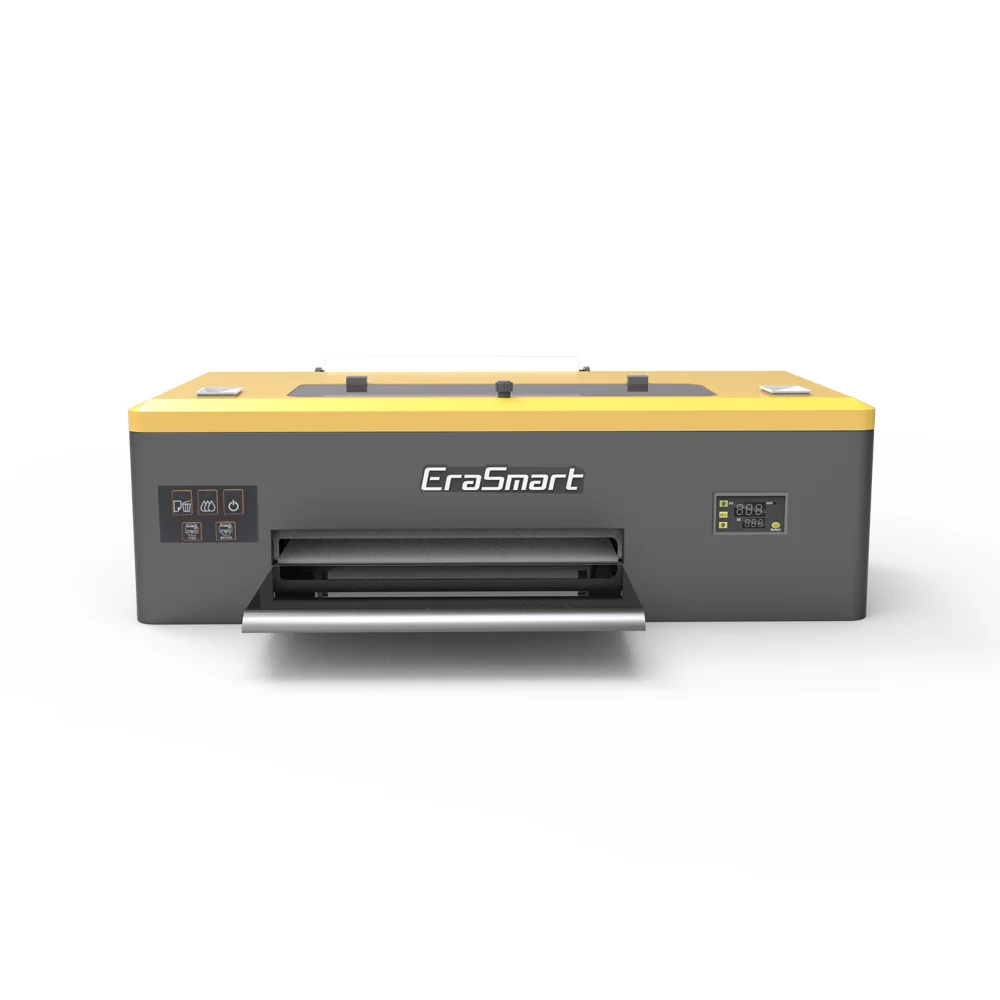
Modèle de tête d'impression L1800 offrant une reproduction de couleurs supérieure pour des conceptions détaillées.
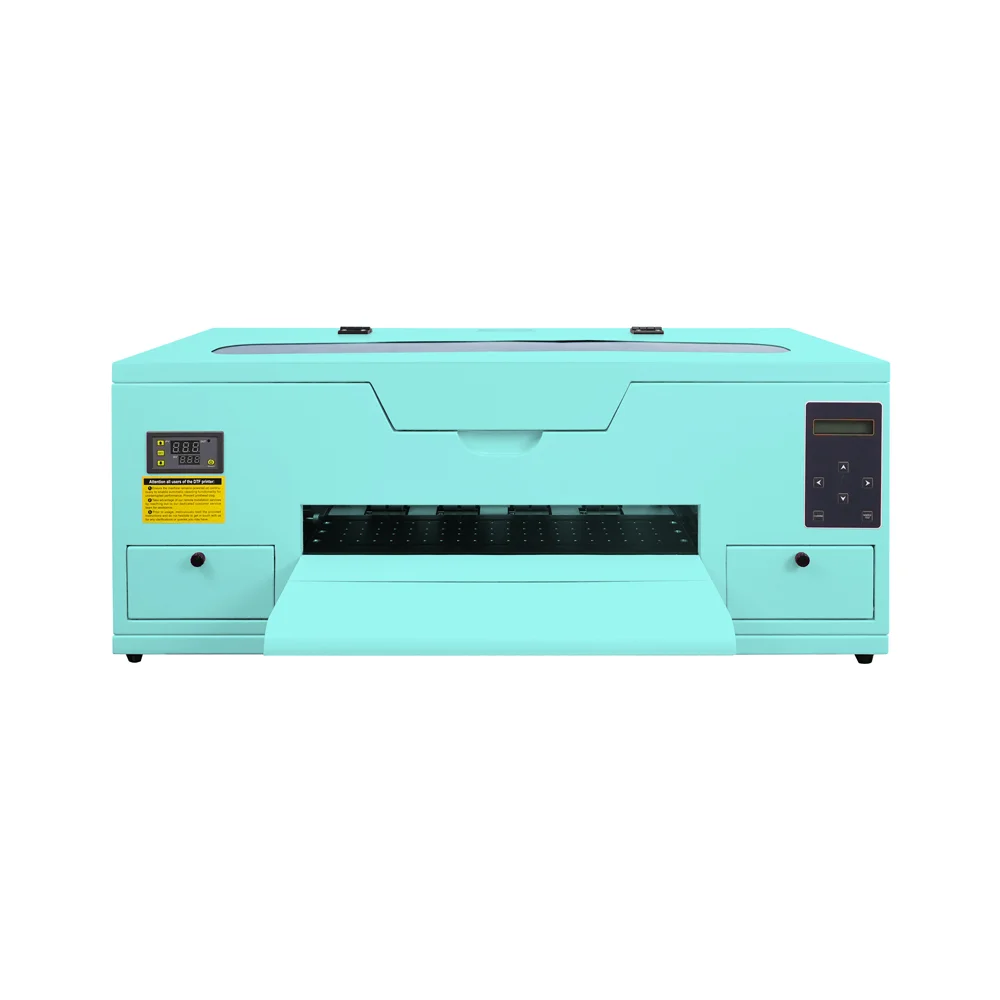
Série A3 MAX avec tête d'impression XP600 pour une vitesse et une efficacité accrues.

Imprimante A3 Max DTF
Modèle A3 haute performance avec tête d'impression DX7 pour les résultats professionnels.
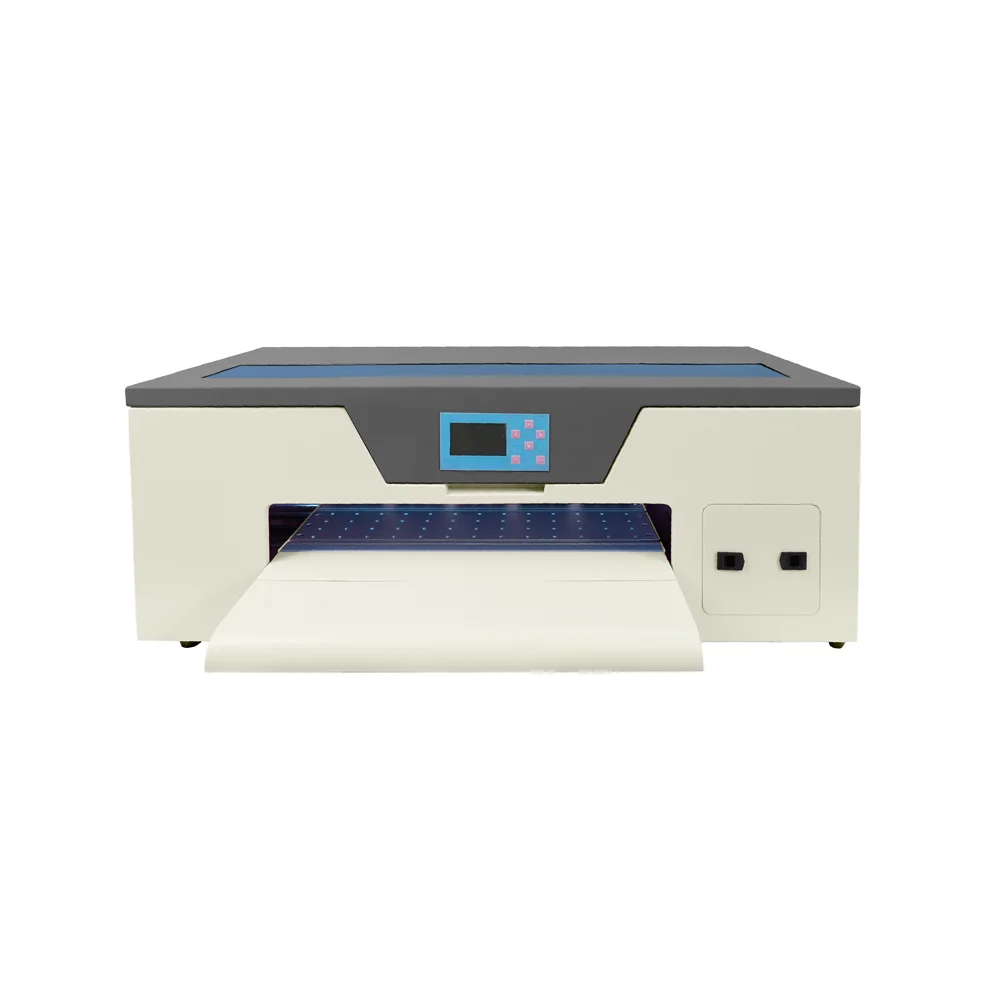
Modèle A3 haute performance avec têtes d'impression XP600 pour les résultats professionnels.
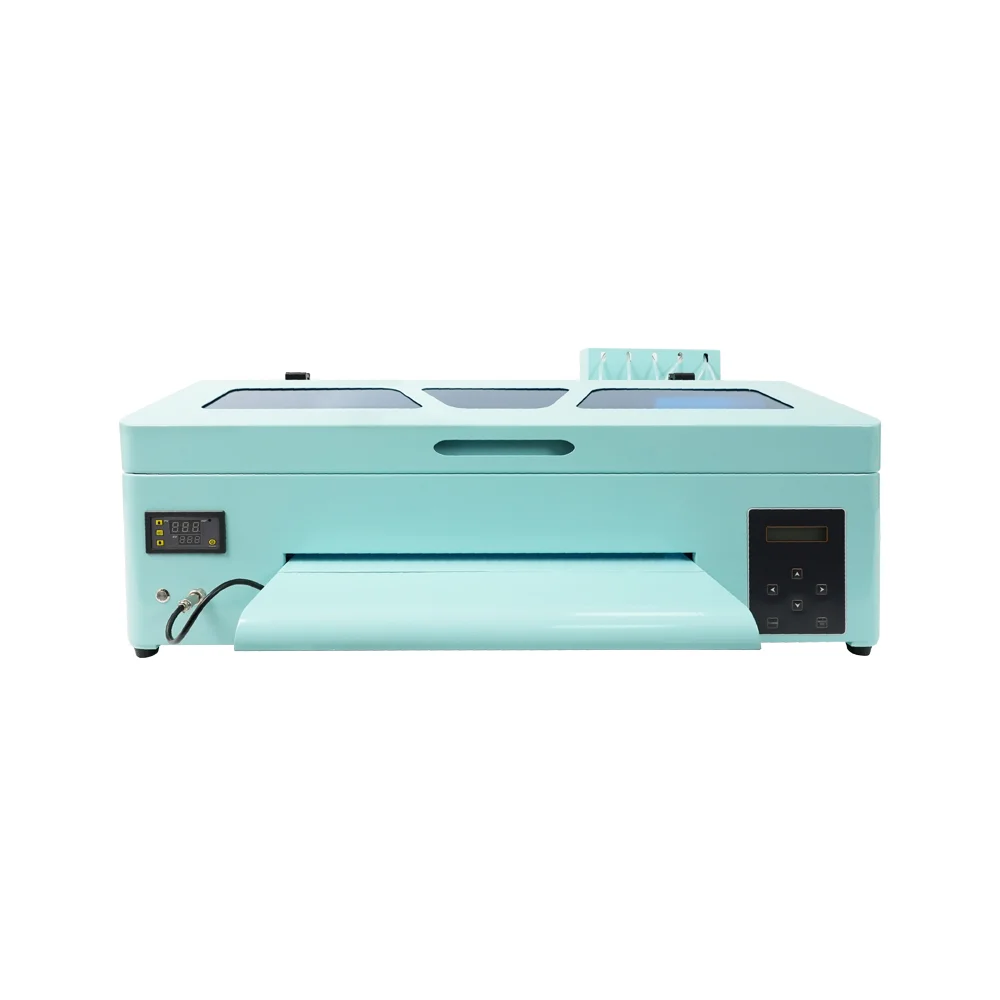
Imprimante professionnelle de la tête A3 à double imprimé pour une production à haut volume.
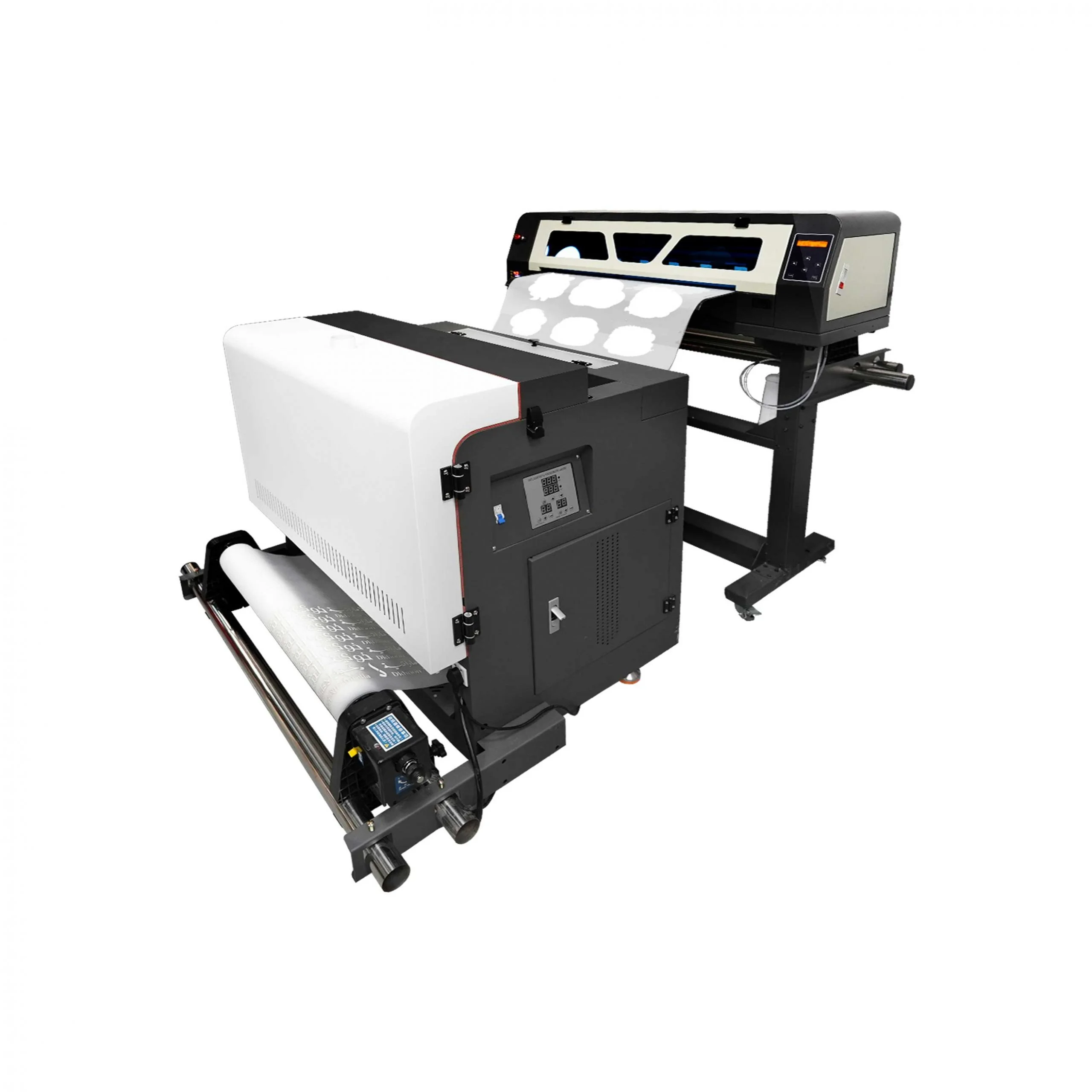
Imprimante industrielle large format avec deux têtes XP600 (largeur de 620 mm).

Modèle industriel à grande vitesse avec deux têtes I1600 (sortie 10㎡ / h).

Imprimante industrielle premium avec deux têtes I3200 pour une productivité maximale.
10 raisons pour lesquelles les magasins choisissent DTF
1) Véritable polyvalence du tissu
Un transfert fonctionne sur les articles en coton, poly, mélanges, nylon et cuir traité. Idéal pour les commandes mixtes (ensembles d’équipe, kits d’entreprise) sans changer la chimie.
2) Pas de prétraitement, moins de variables
Le DTF élimine l'étape de prétraitement courante dans le DTG pour les vêtements foncés, réduisant ainsi le travail, les défauts (taches, halos) et la variabilité.
3) Batchability et liberté d’inventaire
Imprimer des transferts en masse, stock par taille ou design, et appuyez sur pendant les heures de pointe. Parfait pour le commerce électronique, les pop-ups et la réalisation d'événements.
4) Détails nets et petit texte
Avec un RIP et des profils appropriés, le DTF retient mieux les lignes fines, les codes QR et les microtextes que la plupart des alternatives de transfert thermique.
5) Graphiques durables et prêts à laver
Durcissement et rendement de presse corrects excellente solidité au lavage avec une bonne récupération d'étirement. (Validez toujours entre 10 et 20 cycles de lavage à domicile pour vos SKU.)
6) Configuration inférieure par rapport à la sérigraphie
En couleur, sans écrans, sans séparations de couleurs et sans minimum. Idéal pour ponctuels et des séries courtes à moyennes.
7) Consommables économiques
Film + poudre sont des coûts prévisibles ; efficacité de l'encre convient aussi bien aux couleurs unies qu'aux dégradés.
8) Empreinte compacte et évolutive
Une imprimante, une unité de poudre/durcissement (ou un four) et une presse à chaud s'intègrent dans des espaces modestes. Ajoutez des voies à mesure que le volume augmente.
9) Personnalisation conviviale
Les noms, numéros, localisations et micro-lots deviennent rentables : imprimez uniquement ce qui se vend.
10) Qualité constante entre les opérateurs
Moins de variables de traitement par voie humide facilitent la formation du personnel et maintiennent une production reproductible.
Impression DTF par rapport aux autres méthodes d'impression
| Méthode | Meilleure utilisation | Points forts | Limites |
|---|---|---|---|
| DTF | Tout en tissu en couleur ; sur demande | Aucun prétraitement ; pouvant être mis en lots ; détails nets ; configuration faible | Nécessite un film et une poudre ; la discipline de la presse est importante |
| DTG | T-shirts mode en coton, imprimés photoréalistes | Main très douce sur le coton ; impression directe | Prétraitez les tons foncés ; limites de tissu ; entretien plus élevé |
| Impression d'écran | Grands tirages de tons directs | Coût le plus bas à volume élevé ; ultra-durable | Configuration élevée ; pas idéal pour les petits tirages ou les couleurs |
| HTV (Vinyle) | Noms/numéros, dessins simples | Coût d'équipement simple et faible | Travail de désherbage ; détails fins limités ; piles multicolores |
| Sublimation | 100% polyester, blanc/clair | Teintures vibrantes et permanentes | Polyester uniquement ; pas de vêtements sombres |
Qui devrait investir dans une imprimante DTF ?
- Startups et petites entreprises: Faible coût d’entrée, facile à utiliser et impression à la demande rentable.
- Boutiques de vêtements personnalisés: Élargissez les offres de produits sans limitations de tissu.
- Imprimantes d'écran: Ajoutez une capacité d’impression numérique sans remplacer les méthodes existantes.
- Entreprises de commerce électronique: Répondez aux petites commandes avec des designs personnalisés.
- Entreprises de marque d’entreprise: Produisez des uniformes durables, des produits promotionnels et des cadeaux.
Conseils pour choisir la bonne imprimante DTF
Lors de la sélection d'une imprimante DTF, considérez :
- Taille d'impression: A3 vs A2 vs grand format.
- Système d'encre: Réservoirs d'encre en vrac vs cartouches.
- Type de pelage: Compatibilité film peeling à chaud ou peeling à froid.
- Assistance après-vente: Garantie, formation et disponibilité des pièces détachées.
- Vitesse de production: Correspond à la demande de votre entreprise.
Coût et retour sur investissement : un modèle simple que vous pouvez adapter
Hypothèses (exemple) :
- Zone d'image A4 (~8,3×11,7″)
- Film + poudre : 0,35 $ à 0,60 $ par A4
- Encre: 0,20 $ à 0,45 $ par graphique couleur A4
- Travail de presse et frais généraux : 0,40 $ à 0,70 $ par unité (temps opérateur + utilitaires)
Coût estimé du transfert par maillot : 0,95 $ à 1,75 $
Prix de vente typique d’un t-shirt personnalisé en couleur : 15 $ à 30 $ (vente au détail) / 8 $ à 15 $ (de gros).
Marge brute reste sain même à faible quantité ; la personnalisation peut entraîner des primes.
Astuce : suivre couverture d'encre par conception dans votre RIP pour citer en toute confiance.
Qualité et durabilité : comment bien faire les choses
- Encre et sous-base blanche : Calibrez la densité du blanc pour l'opacité sans surencre.
- Fenêtre de guérison : Faire fondre entièrement la colle sans surcuisson (jaunissement, sensation cassante).
- Appuyez sur Paramètres : Verrouillage de la température (vérifié au plateau), même la pression, et le temps de séjour.
- Test de lavage : Validez votre recette par tissu, détergent et méthode de séchage.
- Qualité du film/poudre : Les films de qualité supérieure se décollent plus proprement et sont plus doux au toucher ; les poudres diffèrent par leur point de fusion et leur élasticité.
Là où DTF excelle (cas d'utilisation)
- Produits dérivés et streetwear : Micro-gouttes tendance, réapprovisionnements rapides sans inventaire mort.
- Équipes et vêtements de travail : Ensembles de noms, numérotation, badges de sponsor, logos haute visibilité.
- Entreprises et écoles : Des kits en tissus mixtes dans tous les départements et clubs.
- Événements et visites : Transferts pré-imprimés, appuyez en direct pour des moments personnalisés.
- Exécution et POD : Centralisez l’impression et expédiez les transferts vers les magasins satellites pour le pressage local.
Le flux de travail DTF (étape par étape)
- Conception et RIP → Profils ICC, sous-base blanche, starter/purge selon besoins
- Imprimer sur film → CMJN puis blanc, ou simultané selon la configuration de la tête
- Application de poudre → Robe uniforme ; récupérer l'excédent
- Guérir → Unité four/shaker jusqu'à la fonte spécifiée ; éviter de brûler
- Presse → Temps/Température/Pression selon les spécifications du tissu et du film ; peeling froid/chaud
- Post-presse (facultatif) → Deuxième pression pour une main et une durabilité améliorées
Notes de sécurité et environnementales
- Encres pigmentées à base d'eau et à faible odeur
- Manipulez la poudre adhésive pour minimiser la poussière en suspension dans l'air; utiliser l'extraction lorsque cela est possible
- Entretenir les presses/fours ; confirmer les charges électriques et la sécurité thermique
- Suivez la FDS pour les encres, les poudres et les nettoyants
Liste de contrôle d'achat
- Largeur et vitesse d'impression : Correspondre au volume de commandes quotidien ; envisagez l'impression par lots pendant la nuit
- Circulation de l'encre blanche : Essentiel pour la disponibilité et la santé des buses
- Shaker/Curer Control: Temps stables, même durcissement, récupération de poudre
- Qualité de la presse à chaud : Température précise, pression uniforme sur le plateau
- RIP et gestion des couleurs : Profils ICC, gestion des files d'attente, suivi de l'encre
- Consommables: Ensemble film et poudre éprouvé ; approvisionnement constant
- Assistance et formation : Recettes, planning de maintenance, accès aux pièces détachées
FAQ sur les imprimantes DTF
1. Les imprimantes DTF sont-elles meilleures que les imprimantes DTG ?
Oui, dans la plupart des cas. Le DTF fonctionne sur plus de tissus, ne nécessite aucun prétraitement et est plus rentable. Le DTG offre cependant toujours une douceur inégalée sur du 100 % coton.
2. Combien de temps durent les impressions DTF ?
Avec un pressage à chaud approprié, les impressions DTF durent 50 à 100+ lavages sans se fissurer ni se décolorer.
3. Les imprimantes DTF peuvent-elles imprimer sur du polyester et du nylon ?
Oui. C’est un énorme avantage par rapport à la sublimation et au DTG.
4. Quelle est la différence entre un film PET pelable à chaud et un film PET pelable à froid ?
- Peeling chaud: Production plus rapide, finition mate.
- Peeling à froid: Finition brillante, idéale pour les petits détails.
5. Combien coûte l’exploitation d’une imprimante DTF ?
Le coût par impression dépend de l'utilisation de l'encre, de la poudre et du film, mais généralement inférieur au DTG et au HTV.
6. Les transferts se fissureront-ils après le lavage ?
Quand entièrement durci et pressé correctement, le DTF résiste bien aux lavages répétés. Un mauvais durcissement ou une basse pression provoque des échecs : validez votre recette.
7. Puis-je appuyer sur du nylon ou du sport extensible ?
Oui, testez d'abord. Des températures légèrement plus basses et un pelage soigneux sont souvent utiles ; certains nylons nécessitent des films/adhésifs spéciaux.
8. Ai-je besoin de transferts différents pour les tissus clairs et foncés ?
Un transfert bien profilé avec sous-couche blanche fonctionne pour les deux ; les couleurs restent vives sur les tons sombres.
9. Y a-t-il des limites de quantité minimale de commande ?
Non. Le DTF est parfait pour pièces uniques et des micro-lots, tout en restant rentable pour les séries de taille moyenne.
10. La maintenance est-elle difficile ?
Des vérifications quotidiennes des buses et un entretien simple (essuie-glaces, station de bouchage, agitation douce du blanc) maintiennent une disponibilité élevée.
Conclusion
Choisissez un imprimante DTF si tu veux impressions en couleur indépendantes du tissu, une préparation minimale et la capacité de imprimer maintenant, appuyer plus tard pour une réalisation agile. Pour les magasins qui abandonnent le vinyle ou ajoutent du DTG/écran, DTF offre des gains immédiats en délai d'exécution, polyvalence et marge.
Si vous avez besoin d'aide pour sélectionner les largeurs d'imprimante, les flux de travail RIP et les jeux de films/poudres, ou si vous souhaitez des transferts d'échantillons, parlez-moi de vos vêtements, de vos volumes et de vos objectifs de marque, et je définirai une configuration qui évolue avec votre entreprise.
Peut-être que tu as aussi
Imprimante EraSmart
imprimante uv
imprimante DTF
Imprimante DTG
Presse à chaud
Imprimeur publicitaire
Outils d'impression
four DTF
Presse à chaud
Machine à découper
Tasse transfert de chaleur
Machine de laminage
Consommables
Encre à imprimer
Cas de téléphone portable
Produit en verre
Liquide nettoyant
Coton-tige
Contactez-nous
WhatsApp: +8618566233796
WeChat: +8618566233796
Mobile: +8618566233796
Web :www.erasmart.com
Boutique:www.erasmartmall.com
WhatsApp nous
Demander un devis
Fournissez simplement quelques détails et nous vous aiderons à obtenir des citations rapides!


